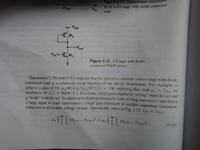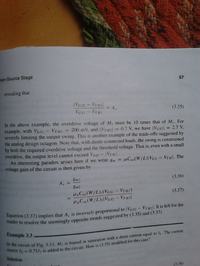iVenky
Advanced Member level 2
- Joined
- Jul 11, 2011
- Messages
- 584
- Helped
- 37
- Reputation
- 76
- Reaction score
- 35
- Trophy points
- 1,318
- Location
- College Station, Texas
- Activity points
- 6,124
Hello. I have a doubt in a topic in the CMOS book by Razavi. It's in page 57. Anyway I will tell you the question
Consider the drain of the common source is connected to a diode connected NMOS. It can be seen clearly that
Gain Av= gm1/gm2. (approx) and at the same time Av= (W/L)1 / (W/L)2.
If we write gm in terms of W/L and overdrive voltage, we get Av to be inversely proportional to the overdrive of transistor 2 and directly proportional to the overdrive of transistor 1. But if we find Av , by equating the drain current of both the transistors (which is same by the way) then Av seems to be directly proportional to the overdrive of transistor 2 and inversely proportional to the overdrive of transistor 1. Razavi has left for the reader to find out the reason behind this. I couldn't find out the reason.
Could you please help me with this?
Thanks in advance.
Consider the drain of the common source is connected to a diode connected NMOS. It can be seen clearly that
Gain Av= gm1/gm2. (approx) and at the same time Av= (W/L)1 / (W/L)2.
If we write gm in terms of W/L and overdrive voltage, we get Av to be inversely proportional to the overdrive of transistor 2 and directly proportional to the overdrive of transistor 1. But if we find Av , by equating the drain current of both the transistors (which is same by the way) then Av seems to be directly proportional to the overdrive of transistor 2 and inversely proportional to the overdrive of transistor 1. Razavi has left for the reader to find out the reason behind this. I couldn't find out the reason.
Could you please help me with this?
Thanks in advance.

